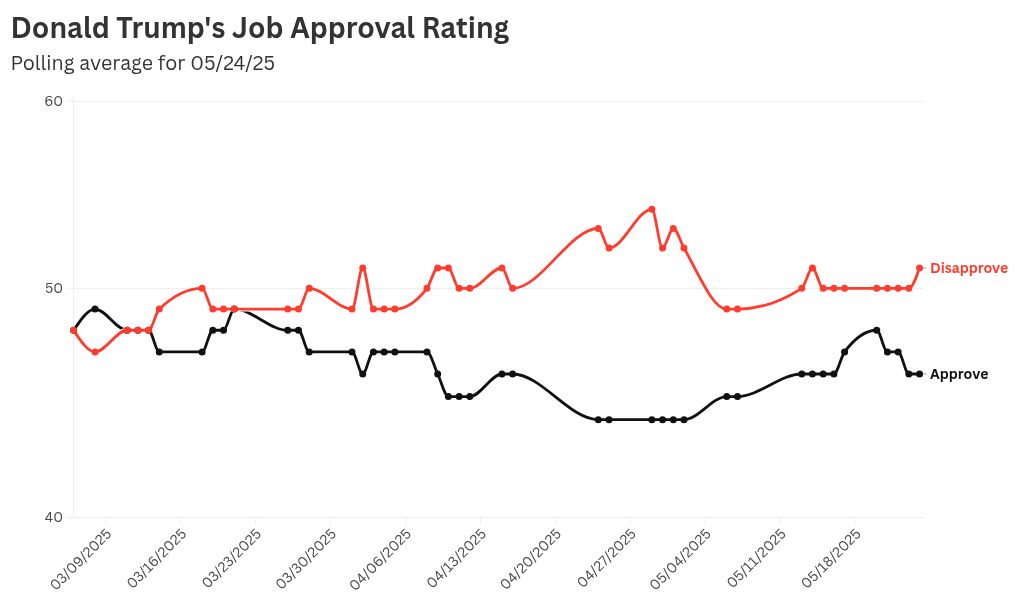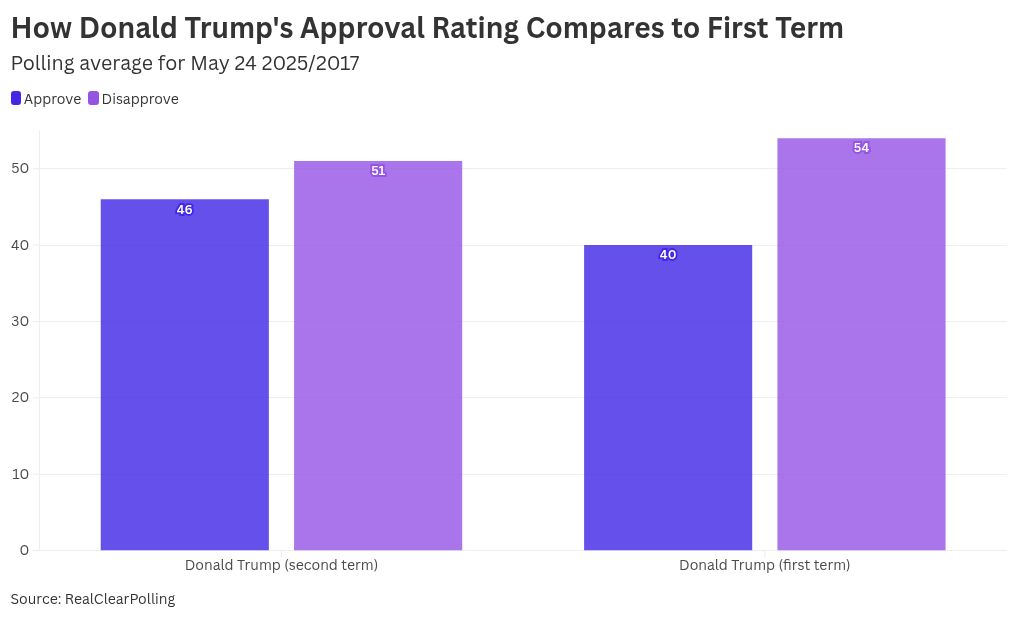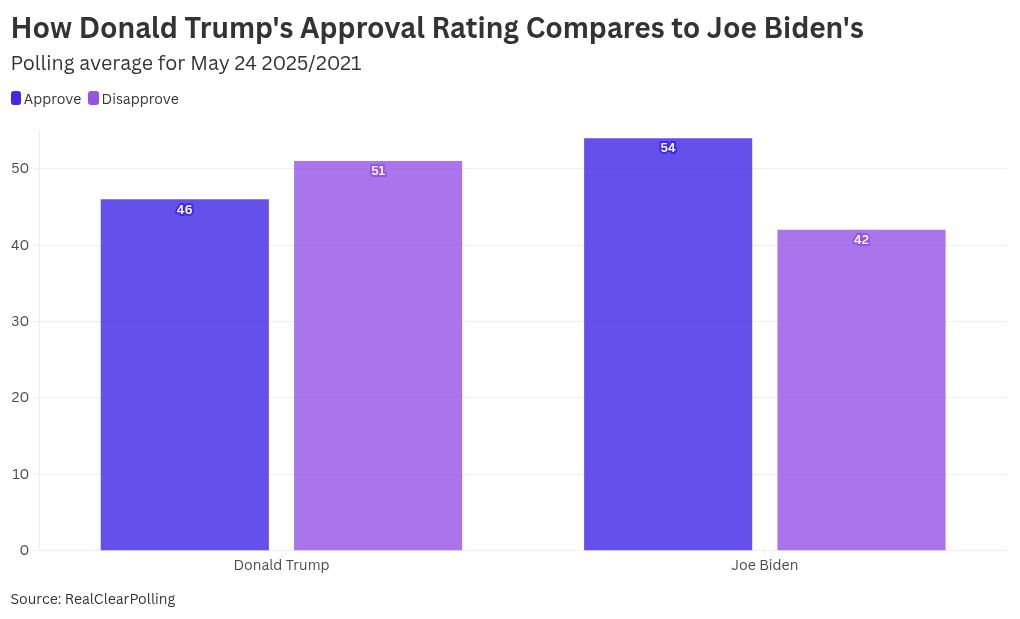President Donald Trump‘s approval rating has dipped into negative territory, according to a poll conducted by a Republican-leaning pollster.
The latest RMG Research/Napolitan News poll, conducted between May 14-21 among 3,000 registered voters, shows Trump’s approval rating at 48 percent, while 50 percent disapprove. The poll had a margin of error of +/- 1.8 percentage points. That is down from a 52 percent approval rating and a 48 percent disapproval rating in early May.
All but one RMG Research poll has shown Trump’s approval rating above water since his second term began, varying between 55 and 49 percent.
The only survey to show Trump with a net negative approval rating was a mid-April poll, taken just weeks after he unveiled his “Liberation Day” tariffs. The move triggered a temporary Dow Jones crash and stoked fears of rising inflation and an impending recession, causing his approval numbers to sink across the board. According to that poll, 48 percent approved of Trump’s performance, while 51 percent disapproved.
Other polls conducted between then and the beginning of May saw his approval and disapproval ratings fluctuating between 48 and 49 percent, suggesting that Trump’s approval rating is stabilizing again.
Why It Matters
Recent polls had shown Trump’s approval rating creeping back up after a period of decline following the introduction of his “Liberation Day” tariffs in April, which saw the stock market fall.
But polls published in recent days show a more complicated picture of Trump’s support.
What To Know
The majority of polls published in recent days have shown Trump’s net approval ratings deep underwater, but they paint a mixed picture.
Some polls have shown his approval ratings ticking up in recent days. That includes Newsweek’s tracker, which shows that Trump’s approval rating currently stands at 46 percent, while 51 percent disapprove of the president. Earlier this month, his approval rating stood at 44 percent, while his disapproval rate was firmly in the 50s.

The latest Insider Advantage poll, conducted between May 17 and 19 among 1,000 likely voters, gave Trump a net approval rating of +11 points, with 55 percent approving and 44 percent disapproving. That was up from a net approval rating of +2 points in early May, when 46 percent approved and 44 percent disapproved.
And the latest Morning Consult poll also showed a surge in Trump’s approval rating, with 48 percent approving and 50 percent disapproving, giving the president a net approval rating of -2 points, his highest approval rating since mid-March. This is up from -7 in early May, when he had a 45 percent approval rating and 52 percent disapproved.
Meanwhile, the latest J.L. Partners/Daily Mail poll conducted between May 13 and 14 among 1,003 registered voters put Trump’s approval rating at 50 percent, up 5 points from 45 percent in April.
The overarching trend in the polls is one of stability, with some showing that his ratings have not substantially changed beyond a 1- or 2-point dip—within the margin of error—or have not changed at all.
That includes the most recent Navigator Research poll, conducted between May 15-18 among 1,376 registered voters, which showed Trump’s approval rating stands at 44 percent, while 54 percent disapprove. That is unchanged from April.
Similarly, in Quantus’ latest poll, conducted between May 18-20, Trump’s approval rating stood at 48 percent, while 48 percent disapproved. That is unchanged from a poll conducted earlier in May, and an April poll also showed his approval rating stood at 48 percent, while his disapproval rating was 2 points higher at 50 percent.
Marquette’s most recent poll also showed his approval rating unchanged from March, while an American Research Group poll, conducted between March 17 and 20 among 1,100 adults, put Trump’s approval rating at 41 percent, down just 2 points from 43 percent in April. His disapproval grew from 53 percent to 55 percent.
A YouGov/Economist poll conducted from May 16 to 19 pegged Trump’s approval at 43 percent, up 1 point from 42 percent the previous week, while disapproval ticked down slightly from 52 percent to 51 percent. The same pattern occurred in the latest Civiqs poll, conducted between May 17 and 20 among 1,018 registered voters.
And in Gallup’s latest poll, conducted between May 1 and May 18 among 1,003 adults, Trump’s approval rating fell by 1 point to 43 percent, while his disapproval rating remained unchanged since April at 53 percent.
Thomas Gift, an associate professor of political science and director of the Centre on U.S. Politics at University College London, told Newsweek that the stability in Trump’s polling numbers is “emblematic of a deeply polarized electorate.”
“His floor of support has proven incredibly durable over time, even amid huge major controversies and unflattering media coverage,” he added.
How Trump’s Approval Rating Compares To First Term
The RealClearPolitics tracker shows that on May 24, 2017, Trump’s approval rating was 40 percent, while his disapproval rating was 54 percent. This gave him a net approval rating of -14 points, making Trump more popular now than at the same point in his first stint in the Oval Office.

How Trump’s Approval Rating Compares To Biden’s
Trump’s 46 percent approval rating is lower than that of former President Joe Biden at the same point in his presidency. On May 24, 2021, Biden stood at 54 percent, with a disapproval rating of 42 percent, according to RealClearPolitics.
While Trump began his second term with his highest approval rating, according to Gallup’s first poll of Trump’s second term, conducted between January 21 and 27, he was still less popular than any president since 1953 at the start of a term and the only one to begin with a sub-50 percent approval rating. Gallup said Biden started his first term with a 57 percent approval rating.
According to data compiled from Gallup by The American Presidency Project, Trump ranks far below other recently elected presidents after 100 days, dating to Dwight Eisenhower, who had an approval rating of 73 percent.
Other recently elected presidents with higher approval ratings at the 100-day mark include John F. Kennedy, 83 percent; Richard Nixon, 62 percent; Jimmy Carter, 63 percent; Ronald Reagan, 68 percent; George H.W. Bush, 56 percent; Bill Clinton, 55 percent; George W. Bush, 62 percent; and Barack Obama, 65 percent.

What Happens Next
Trump’s approval rating could fluctuate in the coming weeks, depending on the outcome of key events, including critical negotiations in the Russia-Ukraine war, the evolving tariff situation and concerns about a recession.
The post Donald Trump’s Approval Rating Goes Negative With Republican Pollster appeared first on Newsweek.




